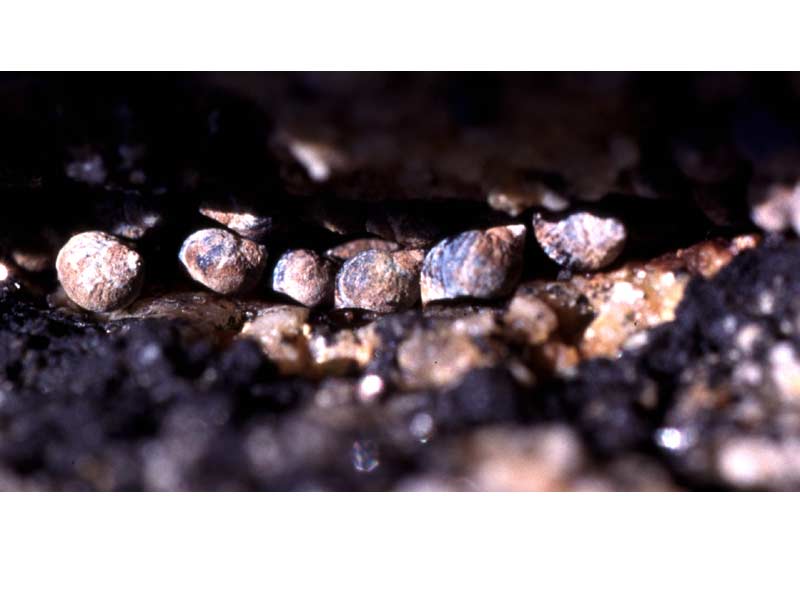Small periwinkle (Melarhaphe neritoides)
Distribution data supplied by the Ocean Biodiversity Information System (OBIS). To interrogate UK data visit the NBN Atlas.Map Help
| Researched by | Paolo Pizzolla | Refereed by | This information is not refereed |
| Authority | (Linnaeus, 1758) | ||
| Other common names | - | Synonyms | Littorina neritoides (Linnaeus, 1758) |
Summary
Description
Recorded distribution in Britain and Ireland
Found on most British and Irish coasts, although it is absent from the southern North Sea shores and has not been recorded east of the Isle of Wight on the Channel coast.Global distribution
Recorded around the British Isles, European coast, Mediterranean, northwest coast of Africa and a single recorded on the east coast of America.Habitat
Melarhaphe neritoides lives high on the rocky shore in cracks and crevices, in Lichina pygmaea tufts and in empty barnacle tests. Its upper limit on the shore is determined by the level of wave exposure of the shore, and it often occurs several metres above high water on the most exposed shores.Depth range
0-1.5 mIdentifying features
- Up to 9 mm in height.
- High pointed spire and flat sides.
- Shell resembles grape pip.
- Dark bluish to blackish brown in colour.
Additional information
It feeds primarily on black lichens and detritus. Breeding occurs from autumn to spring. Please note the identification of Melarhaphe neritoides has been confused with that of Paludinella globularis (syn. littorina) and records of either species may be misattributed to the other (see WoRMS). Kadolsky (2012) reported that the original description of type species of Paludinella littorina (originally described as Helix littorina Delle Chiaje, 1828), was most probably based on small specimens of Melarhaphe neritoides (Linnaeus, 1758). The original type description was, therefore, incorrect. In addition, Pfeiffer (1841) based the genus Paludinella on the taxonomic extension given to that name by Philippi (1841), i.e. a misidentified type species. Furthermore, Kadolsky noted that the correct name for specimens of P. littorina is, in fact, P. globularis. Therefore, for specimens of Paludinella littorina of authors, non Delle Chiaje, Kadolsky restored the name Paludinella globularis and designated the latter as type species of Paludinella (Kadolsky, 2012; Bouchet, 2012).
Listed by
- none -
Bibliography
Fish, J.D. & Fish, S., 1996. A student's guide to the seashore. Cambridge: Cambridge University Press.
Graham, A., 1988. Molluscs: prosobranchs and pyramellid gastropods (2nd ed.). Leiden: E.J. Brill/Dr W. Backhuys. [Synopses of the British Fauna No. 2]
Hayward, P., Nelson-Smith, T. & Shields, C. 1996. Collins pocket guide. Sea shore of Britain and northern Europe. London: HarperCollins.
Hayward, P.J. & Ryland, J.S. (ed.) 1995b. Handbook of the marine fauna of North-West Europe. Oxford: Oxford University Press.
Howson, C.M. & Picton, B.E., 1997. The species directory of the marine fauna and flora of the British Isles and surrounding seas. Belfast: Ulster Museum. [Ulster Museum publication, no. 276.]
JNCC (Joint Nature Conservation Committee), 1999. Marine Environment Resource Mapping And Information Database (MERMAID): Marine Nature Conservation Review Survey Database. [on-line] http://www.jncc.gov.uk/mermaid
Kadolsky, D., 2012. Nomenclatural comments on non-marine molluscs occuring in the British Isles. Journal of Conchology, 41 (1), 65-90.
Datasets
NBN (National Biodiversity Network) Atlas. Available from: https://www.nbnatlas.org.
OBIS (Ocean Biodiversity Information System), 2025. Global map of species distribution using gridded data. Available from: Ocean Biogeographic Information System. www.iobis.org. Accessed: 2025-08-08
Citation
This review can be cited as:
Last Updated: 13/08/2007



